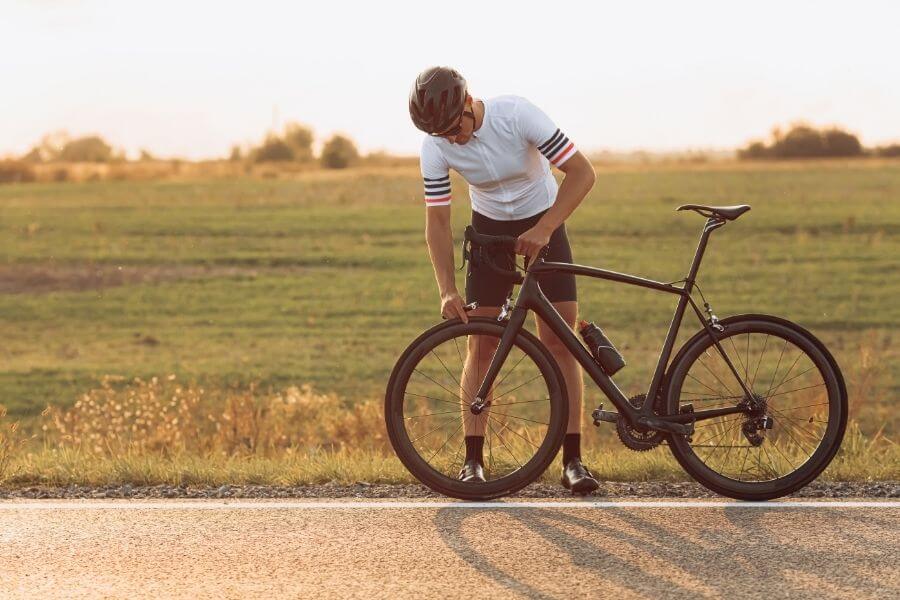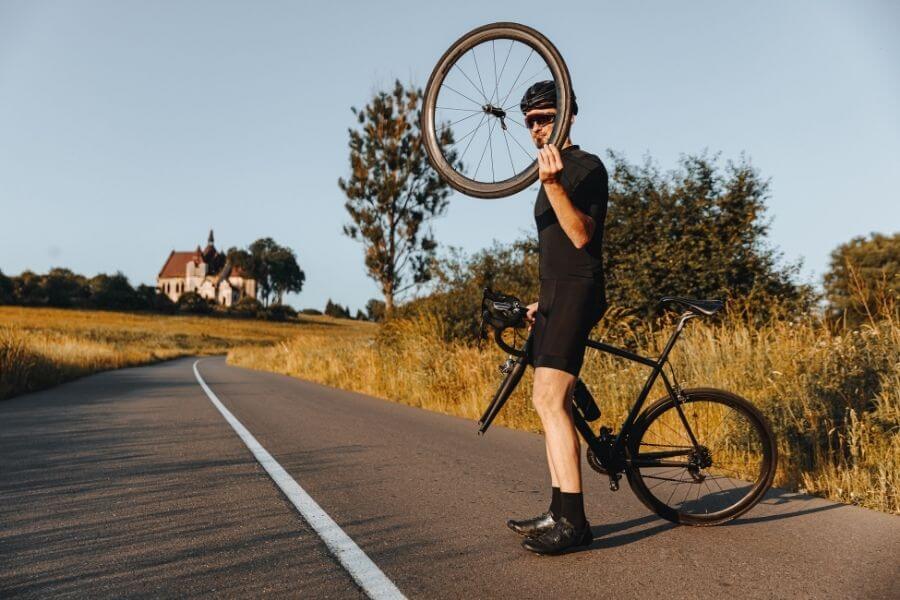Wheels are a basic bicycle component and charge capital importance both in driving and safety. Keep in mind that we are talking about the component that is in contact with the ground. The
Wheels of a road bike They are the first elements of the bicycle to receive the vibrations of the asphalt when we roll to roll and are also the first to feel the changes of firm. And significantly influence the pedaling and braking quality.
Only for these aspects it is very important to have quality wheels. But not always the most beautiful, light wheels or with the biggest profile are the best. There are many other factors that determine the type of optimal wheels, without the need to make a great economic disbursement. In this guide we list the characteristics in which you must fix to identify your ideal road wheels.
Parts of the wheels: tires, radios, tires, bushings and more
Before you look for models of one brand, it is convenient to be clear about the characteristics of each of the parts of the wheel. All of them have a concrete function and determine their behavior.
Tires
The tire is the metal ring of the wheel, whose width determines the placement and also the behavior of the tire. A wider, improve lateral stiffness and tread coefficient. That is, there is less rubbing with the asphalt.
As for the profile, the width of the side wall of the tire, determines the braking quality if shoe brakes are used. And whether they are of discs or shoes, the greater the aerodynamic improvement is proven, especially at relatively high speeds (above 30 km/h).
Tires
It is of little use with quality wheels, with the best design and materials, if inadequate covers are then chosen, with low resistance to the punctures. You should always be clear about the three types of road cover:
Camera (or Clincher)
It is the classic camera cover, easy to mount and disassemble, although heavier and less resistance to punctures.
Tubular
The tubular is a type of tire mainly used in the world of competition. In it covers and chamber are merge by creating a single piece, so it is lighter than the conventional tire. Also better mitigate air loss in case of puncture. Although they are more expensive and their installation on the tire (they are glued with an adhesive) is more complex.
TUBELESS
The Tubeless is a type of roof that enjoys great popularity in the Mountain Bike segment and that gains more road adherents. Its main advantage is that it does not require air chamber. It has a specific shape that hooks the walls of the tire, leaving a sealed cavity inside with anti -snap fluid. This liquid seals the tire housing in case of drilling and does not lose air. They are lighter wheels of the Clincher type, although their assembly and maintenance is more complex.
In addition to this basic typology, you should also look at the width of the tire: the standard is 25 mm. Although many series models already include 28 mm or 30 mm. This involves more advantages: they can inflate to lower pressures, reduce their contact surface with the ground and thus optimize rolling resistance. If you want to know more we recommend you
This post on the use of tubeless wheels on the road.
[Captation Id = "Attachment_6387" Align = "Alignnone" Width = "900"]

Image: Depositphotos[/caption]
Radios
Radios are the great forgotten and undervalued in the wheel chapter. And yet its importance is capital. They are part of the basic structure of every wheel by connecting the tire with its axis. They are also directly involved in the final weight of the wheel, in their levels of lateral and torsional stiffness. And also determine the global resistance of the set.
The most common manufacturing material of radios is steel in most cases, with brass leaders. Although there are also models with aluminum and titanium, but they are less frequent. And your tire number is 28 to 32 in standard models. Although in high range and competition drops to 24 to reduce weight.
Bushings and axes
The
bushings and axes They are the wheel rotation center and its union with the bicycle box. They also determine very important characteristics of the wheel, such as its weight or behavior. In addition, it houses the brake disc and the rear serves as support for the cassette, thanks to its prolongation called the nucleus. Therefore, it is involved in basic bike actions such as pedaling or braking.
Generally the bushings are made of aluminum and house an axis of the same material, which can be traditional rapid release (QR) or intern, of greater diameter (10 and 12 mm) and more rigid.
When choosing new wheels, or even the complete bicycle, we recommend you also examine the type of bushings they carry, the compatibility of their nucleus (for Shiman ceramic).
Bearings
They are housed inside the bushing, they are spherical and are made of steel or ceramic materials. This last aspect is important when differentiating them. Currently many cyclists are investing in the change of bushings with ceramic bearings, as well as their track or cage, also ceramic, to reduce friction and turn resistance.
Most studies in this regard encrypt the improvement of the wheel performance between 20% and 30% with respect to those of steel, as well as their optimal durability. But its cost is quite higher. A bushing with ceramic bearings can double or triple its price with respect to one of steel. But this increase is gradually reducing, with the increasing variety of models in the market.
[Captation id = "Attachment_4250" Align = "Alignnone" Width = "900"]

Image: Depositphotos[/caption]
Materials: Aluminum vs. carbon
The manufacturing material of the tire is another key aspect to choose a wheel. Carbon is the star material of the modality, even for many fans. They are lighter (up to 200 grams per tire with respect to an aluminum) and their stiffness levels are higher. Thus, they end up being more effective when pedaling, stopping or maintaining a certain average speed for a longer time.
Aluminum wheels can be a better option for cyclists that are starting in road cycling. Or those who want to leave relaxed to accumulate kilometers without other more ambitious objectives. The average price savings of a pair of aluminum wheels, with respect to a carbon, is between 600 and 700 euros.
Types of profile, which one suits me?
The
Profile wheels In road cycling they are fashionable and there is a great variety and competence of brands between brands. A larger profile or side wall of the tire, better aerodynamic performance you will get rolling at high speed (above 30 km/h). But the weight will increase when more material is used.
However, a lower profile, below 40 mm, has other benefits that do not count on the average or high profile: less weight, better absorption of the firm and more efficient with lateral wind. They are more recommended road wheels to raise and lower ports or make large backgrounds, or with rough asphalt and in poor condition.
Tire size: 700c or 650b?
Another aspect that goes unnoticed by many cyclists, but has great relevance. The size of the tire or its outer diameter. There are two standardized measures currently: 700c, the most widespread, and 650b. The numbers refer to the external diameter measured in millimeters.
700C tires are more stable at moderate and high speeds and their contact surface with the ground is lower. It is the most used standard.
650b tires are booming in recent years with the development of
Bicicletas Grand Fund, as well as in the Gravel. They are smaller diameter wheels, which implies faster reactions and better manageability in more technical curves or sections. But they end up being less rolling. Its diameter would be equated with those of 27.5 ”in Mountain Bike.
What are TPI?
The TPI is a technical characteristic of the tire that determines its durability and resistance to punctures. It is based on the number of nylon threads per square inch (threads per inch) of the housing. Thus, if you give the performance and lightness, you must have a high TPI cover (more threads and less rubber), greater than 100. On the other hand, if you prefer a durable and resistant cover, opt for one with a low TPI, in Tor at 60 TPI.
The rolling coefficient
We have already talked about the width of the tire, the tire and also of the size (outer diameter). All these values influence the wheel rolling coefficient. It is marked by the trace or contact surface of the tire with the asphalt, being of lower surface as wide and larger diameter is the tire.
But this does not mean that a wider tire is always more efficient. It also has greater air resistance and adds more weight to the bicycle. Therefore, it values if you want to prioritize more comfort, durability and efficiency when rolling (wide covers) or less weight, more aerodynamic but more wear (narrow cover).

Recommended brands and manufacturers
To end this complete guide on road cycling wheels, we make a selection of the main reference brands in the road bike wheel market.
Mavic
Mavic manufactures road wheels for decades. It has a wide range of products, both carbon and aluminum, compatibilities with all market groups (Shimano, Sram, Campagnolo) and a high performance offer tested in the main races of the world. Highlight the Cosmic Carbon and Ksyrum models in aluminum.
Zipp
Zipp is the SRAM wheel brand, with a wide range of road and triathlon models. However, it is somewhat more focused on high performance and its supply in aluminum is somewhat more limited, as well as its compatibility with other groups that are not SRAM. Highlight the 404 high performance series and the 303 endurance/great background. It also has its own tire models.
CAMPAGNOLO
In addition to road transmission groups, the Italian firm stands out for its high performance wheels. It consists of 7 main carbon or aluminum models and all kinds of profiles. As a carbon model, mention the Bora, while in aluminum we recommend the Scirocco or Shamal.
Corima
Corima is a brand specialized in high -performance carbon wheels. It is the choice of several current UCI World Tour teams. Its offer is classified by profiles and also for its compatibility with disc brakes or tire. They are more elitist wheels and faces but of great invoice.
Shimano
We could not ignore the main component manufacturer of the world. Each of its transmission groups (Dura-Ace, Ultegra, 105, etc) has its own wheel game. They are offered in many versions (high, medium and low profiles) and materials (carbon and aluminum). However, they have similar limitations, such as with Zipp, in relation to the nucleus of the cassette and also in the installation of the brake disc (Shimano Center Lock), prioritizing the brand's own standard.
 Image: Depositphotos[/caption]
Image: Depositphotos[/caption]
 Image: Depositphotos[/caption]
Image: Depositphotos[/caption]













